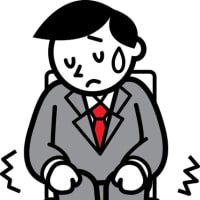Dali Hello, Ina-chan! It’s extremely hot today!
ダリちゃん イナちゃん、こんにちわ~! 今日は無茶暑いね!
Me Indeed, Dali. It’s very hot outside.
私 ほんとだね、ダリちゃん。外はとっても暑いね。
Dali On the way here, I walked down the shotengai. As I was walking down the shotengai, I crossed several streets with pedestrians having the right-of-way.
ダリちゃん ここに来る途中、商店街を歩いていたんだよ。商店街を歩いていると、歩行者に優先権のある通りをいくつも横切ったんだ。

Me What’s “right-of-way”?
私 「ライト・オブ・ウェイ」って何?
Dali Consider the situation where two cars come together at a crossroads. One is required by law to stop, and the other is not. In this case, the latter is said to have the right-of-way.
ダリちゃん 十字路で2台の車が合流する場面を考えよう。一方は法律で一時停車が求められている。で、もう片方は求められていない。この場合、後者が通行優先権を持っているといわれる。
Me Yowza!
私 そうなんだ!
Dali Here in Japan, pedestrians walking down the shotengai always have the right-of-way. So when a car comes, it is required to stop, not us pedestrians. We pedestrians don’t have to stop; we can walk across legally without having to stop.
ダリちゃん ここ日本では、商店街を歩いている歩行者には常に通行優先権がある。で、車が来ると、わしら歩行者じゃなくて、車が一時停止することが求められる。わしら歩行者は一時停止する必要はない。法律上、そのまま渡ることができる。
Me That’s common sense under Japanese law.
私 日本の法律じゃあ、あたりまえ。
Dali But sometimes I see a pedestrian who doesn’t take his right-of-way; instead, he stops, giving up the right, in favor of the car. Maybe he is scared of being hit by the car?
ダリちゃん でもわしは通行優先権を行使しない歩行者をよく見かける。それどころか、その歩行者は、車のために権利を放棄して一時停止するんだよ。たぶん車にはねられるのが怖いのかな?
Me Yes! The driver might be crazy. Or old, or drunk. Or maybe he hates you gaijins.
私 そうだね! 運転者はクレージーかも。それか、老いぼれか、酔っ払いか、君らみたいな外国人が嫌いなのかもね。
Dali Yes. But in almost all cases, the car stops correctly because he knows that pedestrians have the right-of-way. But here is the curious thing. When the pedestrian sees the car stop, he runs across. He runs! Why must he run?
ダリちゃん そうだね。でもほとんどの場合、歩行者に優先権があると知ってるので車はちゃんと止まる。でも奇妙なことがあるんだ。車が止まったのを歩行者が見ると、歩行者は走って渡るんだ。走るんだよ! なんで走らなきゃならないんだ?
Me He probably doesn’t want to inconvenience the driver.
私 たぶんドライバーに不便をかけたくないんだ。
Dali But he has the right-of-way! And the driver knows this as well, and so has stopped! So why does the pedestrian run across? The same thing can be observed when a car turns at an intersection.
ダリちゃん でも、歩行者優先だよ! それにドライバーもそのことを知ってる。だから止まったんだ! じゃあなぜ歩行者は走って渡るの? 同じことが、車が交差点で曲がるときに見受けられる。
Me Tell me! Tell me!
私 何? 何?
Dali Consider the situation where a car attempts to turn at an intersection. However, there is a pedestrian walking through the crosswalk. Naturally, the car must stop to give way to the pedestrian. The driver is entirely correct. However, in Japan, I can often see a pedestrian running across the intersection to avoid delaying the driver and its passengers.
ダリちゃん ある車が交差点で曲がろうとする場面を考えよう。でも、横断歩道を渡っている歩行者がいる。当然ながら、車は歩行者に道を譲るために止まらなきゃならない。ドライバーは全く正しい。でも日本ではドライバーと同乗者を遅らせないように歩行者が走って交差点を渡るのをよく見かける。
Me Probably, he does not want to inconvenience the driver.
私 たぶんドライバーに不便をかけたくないんだ。
Dali But it’s so hot outside! The pedestrian is suffering from hot weather! But the driver, on the other hand, is inside the car, and the windows are up. It’s cool, refreshing, and comfortable inside the car. He is sitting in a relaxed, air-conditioned environment. The pedestrian is walking in the 95-degree summer heat! Why does such a pedestrian rush to benefit the driver ensconced in a relaxed, air-conditioned environment to save such a driver one or two seconds while mouthing, “Gomennasai, gomennasai”?
ダリちゃん でも外はとっても暑いんだよ! 歩行者は暑さで苦しんでいる! でも一方運転手は車の中にいて窓は締め切っている。車内は涼しく、さわやかで、快適。ドライバーはエアコンの効いたリラックスした環境に座っている。歩行者は夏の95度の暑さの中を歩いている! なぜそのような歩行者はドライバーの利益のために急いで走り、エアコンの効いたリラックスした環境で快適に座っているドライバーの1、2秒を節約しようとするのだろうか? 「ごめんなさい、ごめんなさい」と言いながら。

Keywords(キーワード)
right-of-way: (交通上の)優先通行券、先行権
walk down the street: 通りを歩く
pedestrian: 歩行者、競歩者
crossroad: (他の道路と直角に交わる)交差道路、四つ辻、十字路
require: 必要とする、要求する
latter: 後の方の、終りの、後者の、後者
legally: 法律的の、法律上、合法的に
instead: その代わりとして、それよりも
scare: 怖がらせる
curious: ものを知りたがる、好奇心の強い、詮索好きな、不思議な、奇異な
inconvenience: (に)迷惑をかける、不便をかける、不便を感じさせる
observe: 観察する、監視する、気付く、見る
intersection: (道路の)交差点
crosswalk: 横断歩道
entirely: 全く、完全に、もっぱら、ひたすら
delay: (を)遅らせる、延ばす
passenger: 乗客、旅客、搭乗客
suffer from: わずらう、悩まされる
ensconce: (に)(快適に落ち着いて)座る、おさまる
mouth: 言う、発音する
bow: お辞儀する
rush: 急ぐ、突進する、殺到する
honk: 警笛を鳴らす
horn: (自動車などの)警笛
Comments(コメント)
In Japan, even if the pedestrian has the right-of-way, he crosses the intersection quickly while bowing to a waiting driver. In such a situation, I wonder if American pedestrians cross the intersection without rushing. It would be interesting to look into this. I think if the pedestrian crosses the intersection too slowly, the driver might express his anger by honking his horn.
日本では、たとえ歩行者が通行優先権を持っていても、待ってくれているドライバーに会釈しながら足早に交差点を渡る。このような状況でアメリカ人の歩行者は、急ぐことなく交差点を渡るのだろうか? 調べてみると面白いかも。歩行者があまりにもゆっくりと交差点を渡ると、ドライバーはクラクションを鳴らして怒り出すんじゃないかと僕は思う。























